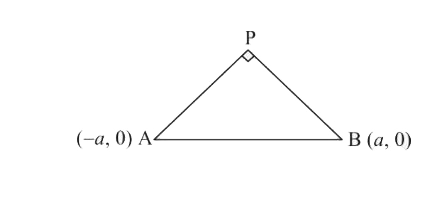A and B are two fixed points and P moves so that PA=nPB. Show that locus of P is a circle and for different values of n all the circles have a common radical axis.
The correct Answer is:Hence for different values of n the circles have a common radical axis.
To solve the problem, we need to show that the locus of point P, which moves such that PA=n⋅PB, is a circle, and that for different values of n, all such circles share a common radical axis.
Step 1: Define the Points
Let A and B be two fixed points in the Cartesian plane with coordinates:
- A(x1,y1)
- B(x2,y2)
Let P(x,y) be the moving point.
Step 2: Express Distances
The distances from point P to points A and B can be expressed as:
- PA=√(x−x1)2+(y−y1)2
- PB=√(x−x2)2+(y−y2)2
Step 3: Set Up the Equation
Given that PA=n⋅PB, we can write:
√(x−x1)2+(y−y1)2=n⋅√(x−x2)2+(y−y2)2
Step 4: Square Both Sides
To eliminate the square roots, we square both sides:
(x−x1)2+(y−y1)2=n2⋅((x−x2)2+(y−y2)2)
Step 5: Expand Both Sides
Expanding both sides gives:
(x−x1)2+(y−y1)2=n2((x−x2)2+(y−y2)2)
x2−2xx1+x21+y2−2yy1+y21=n2(x2−2xx2+x22+y2−2yy2+y22)
Step 6: Rearrange the Equation
Rearranging the equation, we get:
x2+y2−2xx1−2yy1+x21+y21=n2(x2+y2−2xx2−2yy2+x22+y22)
Step 7: Collect Like Terms
Bringing all terms involving x and y to one side results in:
(1−n2)x2+(1−n2)y2−2x(x1−n2x2)−2y(y1−n2y2)+(x21+y21−n2(x22+y22))=0
Step 8: Identify the Circle Equation
This equation can be rearranged into the standard form of a circle:
Ax2+Ay2+2Gx+2Fy+C=0
where A=1−n2, G=−(x1−n2x2), F=−(y1−n2y2), and C=x21+y21−n2(x22+y22).
Step 9: Show Common Radical Axis
For two different values n1 and n2, the equations of the circles can be derived similarly. Subtracting the two equations will eliminate the quadratic terms, leading to a linear equation in x and y, which represents the radical axis.
Conclusion
Thus, we have shown that the locus of point P is a circle and that for different values of n, all these circles share a common radical axis.
Let A and B be two fixed points in the Cartesian plane with coordinates:
- A(x1,y1)
- B(x2,y2)
The distances from point P to points A and B can be expressed as:
- PA=√(x−x1)2+(y−y1)2
- PB=√(x−x2)2+(y−y2)2
Given that PA=n⋅PB, we can write:
√(x−x1)2+(y−y1)2=n⋅√(x−x2)2+(y−y2)2
To eliminate the square roots, we square both sides:
(x−x1)2+(y−y1)2=n2⋅((x−x2)2+(y−y2)2)
Expanding both sides gives:
(x−x1)2+(y−y1)2=n2((x−x2)2+(y−y2)2)
x2−2xx1+x21+y2−2yy1+y21=n2(x2−2xx2+x22+y2−2yy2+y22)
Rearranging the equation, we get:
x2+y2−2xx1−2yy1+x21+y21=n2(x2+y2−2xx2−2yy2+x22+y22)
Bringing all terms involving x and y to one side results in:
(1−n2)x2+(1−n2)y2−2x(x1−n2x2)−2y(y1−n2y2)+(x21+y21−n2(x22+y22))=0
This equation can be rearranged into the standard form of a circle:
Ax2+Ay2+2Gx+2Fy+C=0
where A=1−n2, G=−(x1−n2x2), F=−(y1−n2y2), and C=x21+y21−n2(x22+y22).
For two different values n1 and n2, the equations of the circles can be derived similarly. Subtracting the two equations will eliminate the quadratic terms, leading to a linear equation in x and y, which represents the radical axis.
Thus, we have shown that the locus of point P is a circle and that for different values of n, all these circles share a common radical axis.
Topper's Solved these Questions
- CIRCLE Book:ARIHANT MATHS ENGLISHChapter:CIRCLE Exercise:Exercise For Session 1
Explore 18 Videos
- CIRCLE Book:ARIHANT MATHS ENGLISHChapter:CIRCLE Exercise:Exercise For Session 2
Explore 17 Videos
- BIONOMIAL THEOREMBook:ARIHANT MATHS ENGLISHChapter:BIONOMIAL THEOREMExercise:Exercise (Questions Asked In Previous 13 Years Exam)
Explore 21 Videos
- COMPLEX NUMBERSBook:ARIHANT MATHS ENGLISHChapter:COMPLEX NUMBERSExercise:Complex Number Exercise 8
Explore 2 Videos
Similar Questions
If A and B are two fixed points and P is a variable point such that PA+PB=4, the locus of P is
View SolutionA and B are two fixed points. The locus of a point P such that ∠APB is a right angle, is:

View SolutionA and B are two fixed points. Draw the locus of a point P such that angle APB=90∘.
View SolutionA(2, 0) and B(4, 0) are two given points. A point P moves so that PA2+PB2=10. Find the locus of P.
View SolutionA(2, 0) and B(4, 0) are two given points. A point P moves so that P A 2 + P B 2 = 10 . Find the locus of P.
View SolutionIf A(1,1)andB(−2,3) are two fixed points, find the locus of a point P so that area of ΔPAB is 9 units.
View SolutionA point moves in a plane so that its distance PA and PB from who fixed points A and B in the plane satisfy the relation PA−PB=k(k≠0) then the locus of P is a. a hyperbola b. a branch of the locus of P is c. a parabola d. an ellipse
View SolutionA (a,0) , B (-a,0) are two points . If a point P moves such that ∠PAB−∠PBA=π/2 then find the locus of P.
View SolutionIf A(−1,1)and B(2,3) are two fixed points, find the locus of a point P so that the area of ΔPAB=8sq. units.
View SolutionA(a,0) , B(-a,0) are two point . If a point P moves such that ∠PAB−∠PBA=2α then find the locus of P .
View Solution